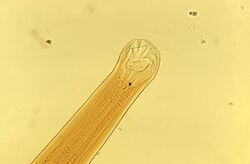| Display title | Biology:Ancylostoma braziliense |
| Default sort key | Ancylostoma braziliense |
| Page length (in bytes) | 10,636 |
| Namespace ID | 3026 |
| Namespace | Biology |
| Page ID | 399358 |
| Page content language | en - English |
| Page content model | wikitext |
| Indexing by robots | Allowed |
| Number of redirects to this page | 0 |
| Counted as a content page | Yes |
| Page image |  |
| HandWiki item ID | None |
| Edit | Allow all users (infinite) |
| Move | Allow all users (infinite) |
| Page creator | imported>SpringEdit |
| Date of page creation | 02:11, 26 October 2022 |
| Latest editor | imported>SpringEdit |
| Date of latest edit | 02:11, 26 October 2022 |
| Total number of edits | 1 |
| Recent number of edits (within past 90 days) | 0 |
| Recent number of distinct authors | 0 |
Description | Content |
Article description: (description)
This attribute controls the content of the description and og:description elements. | Ancylostoma braziliense is a species of hookworm belonging to the genus Ancylostoma. It is an intestinal parasite of domestic cats and dogs. Severe infection is often fatal to these pets, especially in puppies and kittens. The infection is particularly endemic in the southern United States. It is most... |

